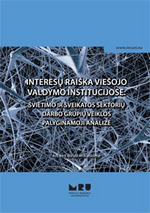Knygos / Books
- Book „Interest Representation at Institutions of Public Governance: Comparative Study of Participatory Groups in Education and Science and Health Sectors”, 2013.
- Chapter in book „Integrated transformations of e-health: perspectives of stakeholders”, 2015.
- Chapter in book „Social technologies and collective intelligence” 2015
- Text book/Vadovėlis „Research and development project management” 2014
- Text book/Vadovėlis „Sprendimų priėmimo metodai viešajam valdymui” 2011
______________________________________________________________
Book Interest Representation at Institutions of Public Governance: Comparative Study of Participatory Groups in Education and Science and Health Sectors
Interest Representation at Institutions of Public Governance:
Comparative Study of Participatory Groups in Education and Science and Health Sectors
Summary
Topicality. The main purpose of public governance is to design such regulatory system for the state that triggers changes in conformity with public expectations, and establishes barriers against undesirable effects in the development of the state. It is widely recognized that public policy is shaped not only by public administrators and politicians, but to a certain extent by the society as well. However, no recommendation on how to ground the policy making process on stakeholders’ participation is self evident. A more extensive involvement of stakeholders contributes advantages of knowledge management to public decision making: participation of various actors serves as a vehicle to convey information about stakeholder needs and the values of stakeholders that could be added to the existing knowledge, provides diverse information about the present situation and outlines an actual state and a desirable result, helps to create new knowledge about possible alternatives and plausible solutions, facilitates creation of consensual knowledge when combining different attitudes of policy actors, secures policy implementation via the use of new knowledge as its own pragmatic justification, serves to acquire knowledge stimulating stakeholders’ learning process for future actions and interest representation. These advantages make the policy making process manageable in a transparent, equitable and rational manner. Although participatory policy is easily justified as an instrument for implementation of democracy, its introduction into existing bureaucratic structures may be challenging. Therefore it is crucial to identify major barriers against public participation in policy making and search for means to overcome the such barriers, including resistance to novelties, risk of failures and unexpected expenses, competition between long-term and short-term goals, overestimation of one’s own competence, knowledge and experience, premature decisions made without having considered possible alternatives and likely consequences, and finally failure of the organizational mechanism of experience accumulation that leads to repetitive mistakes.
Goals and objectives. Contemporary institutions of public governance extensively employ participatory groups with the purposes to outline their policies. However, there is a deficit in extensive studies in whether such groups are proper tools for stakeholders’ interest representation, and how such groups contribute to the reduction of the cleavage between policy makers and the citizen. Therefore, the research presented in this book aims to elaborate a managerial approach towards public policy decision making granting the balance between policy actors and equal distribution of their sakes in policy modelling. Health and education and science sectors were chosen for investigation as the major socially sensitive policy domains. The diverse levels of stakeholders’ recognition and differences in treatment of stakeholders in both sectors make a perfect medium for the comparative analysis of the involvement of actors and for the study of the praxis in participatory policy. The research has several objectives: – to collect empirical data on the instruments applied to involve stakeholders into the public governance institutions that are responsible for health and education and science policies; – to scrutinize the extent of interest representation in these institutions; – to examine interrelations between policy actors and to measure dynamics of such interrelations on the basis of the social network analysis; – to identify managerial barriers and limitations that public governance institutions encounter trying to benefit from stakeholders’ contribution to public policy making; – to design a researched based framework for participatory decision making and to elaborate managerial recommendations for implementation of decisions.
Methodology. The research applies a mixed method technique (combining social network analysis and semi-structural interviews) aimed to produce reliable knowledge, necessary to address phenomena of social relationships that lead towards the development of new policies. The approach of mixed methods could become a powerful instrument that produces comprehensive outputs with the following benefits of the policy analysis: – quantitative analysis produced solid data available to use for further policy decision inputs with particular solutions; – qualitative analysis generated subjective information for interpretation; – mixing of methods gave social value of the data. We explored formal networks of participatory policy composed of temporary participatory groups set by Lithuanian Ministries of Health, and Education and Science. Such groups were established by decrees of the Ministers for various specific purposes. The decrees were used as sources to collect data for the social network analysis. Years 2007 and 2010 were selected as sample periods for the analysis as these were the periods when Lithuania’s governments worked in the most stable and effective manner (the middle of the terms of office). The choice also granted a possibility to compare praxis of different governments in terms of stakeholders’ engagement into policy development. The analyzed documents produced data on: who were involved (names of officially nominated participants), what institutions the participants represented (their affiliations), what goals were set for each participatory group and what time limitations were set for the groups (deadlines for presentation of the results). The social network analysis allowed categorization and identification of associations between participants from different fields. The research involved semi-structural qualitative interviews to measure attitudes of policy actors towards the goals, processes and results of stakeholders’ engagement into policy outlining. The interviews were conducted with policy administrators from the Ministries of Health and Education and Science, and with other policy actors who were intentionally invited into the policy process by policy makers. Participants from different organizations, including both organizers of participatory groups and those invited to participate were interviewed in order to have a possibility to compare interviewees’ expectations and satisfaction with the participation process and results. The quantitative data were collected on three main research topics: – participation and its content (purposes of participatory group; selection of participants; procedures for establishment of the participatory group; roles of the interviewees in the participatory group); – management of participation activities (setting of goals and assignments, organization of work of the participatory group, matching of interests, working atmosphere within the advisory/ decision group, implementation of assignments); – participants’ satisfaction (satisfaction with the performance of the participatory group, satisfaction with the results).
Framework. Both, theories and data of empiric researches were used to elaborate a Participatory Decision Making Framework. The framework is compounded of 5 interconnected sections: 1) the arena for stake expression, which is characterized by transparency, legitimacy and manageability. The components are integrated by good governance introduced by democratic institutions that support the engagement process; 2) completeness of stake representation. This element of the framework is characterised by representativeness and equality; 3) the balance of stake representation is characterised by such categories as an emphasis on the public interest, stimulation of new interests to be conceptualised and reduction of the expression of clear and powerful stakes; 4) research based evidence. This section reflects mutual learning and appropriate scale and scope; 5) monitoring and evaluation of participation quality is characterised by the level of cooperation and collaboration between policy actors and evidence of participation outcomes.
Conclusions. Legal dimension. The results of the research testify that both Education and Science and Health Ministries follow the same legislation to establish participatory groups. The rights to employ such organizational instruments are legitimized in the rules regulating operation of institutions. Actually, participatory groups are the one and the only means that have legal grounding for participation: they are being established by formal ministerial decrees setting the main aspects of each participatory group. Also, it comes out that such groups are mostly being employed by initiatives of the ministries. Participatory groups as fragments of policy networks. Participatory groups may be treated as instruments of interest representation and interest coordination. However, in practice they are applied for other purposes as well. Although participatory groups have a variety of tasks (i.e. problem solution, sharing of information, development of concepts, etc.), the major goal of participatory groups is to acquire expertise instead of interest treatment. The scope of participatory groups. In both Ministries, the majority of policy actors were networked with the purpose to contribute to strategic changes. This fact is especially distinct at the Ministry of Health. However, at the Ministry of Education and Science, a growing number of groups dedicated to solve administrative and internal problems was also identified. That may indicate that participatory groups started to be used as an organizational instrument for maintaining cross-sectional horizontal links, thus reducing significance of application of participatory groups for matching interests with external stakeholders. Interest representation. The research revealed that the potential of stakeholders was not fully utilized: public administrators dominated in participatory groups instead of actual interest representatives. Also, it has been found that external participants, who were the most intensively engaged, were those from universities and other research institutions. Therefore, it is obvious that scientific knowledge and research based evidences were recognized as an important input into public policy. This confirms that participatory groups were exploited as a means for recognition of expert opinions in the first place whereas interest representation was secondary. Interest matching and agreement. The studies demonstrated that when employees of the ministries employed participatory groups with the aim to collect expert opinions, legal mechanisms for horizontal coordination were established. Thus, the groups’ potential to combine diverse interests and reduce emerging confrontations remained unexploited. Seeking to escape ineffective functioning of participatory groups, introduction of actors who represent extensive public interests into decision making process would be of great importance. When the need to recognize input of all stakeholders into the public interest is acknowledged, the dimension of interests’ declaration becomes topical. Until interests are identified and sounded in public, there is no assurance that all interests will be observed and given opportunities to be manifested during the decision making process.
Chaper in book „Integrated transformations of e-health: perspectives of stakeholders”, 2015.

Chapter in book „Social technologies and collective intelligence”, 2015

Šis vadovėlis skirtas racionalių metodų, kurie palengvintų valstybei svarbių sprendimų priėmimo eigą, analizei. Rašant vadovėlį pirmiausia buvo galvojama apie studentus, kurie rytoj dirbs viešojo administravimo institucijose ir dalyvaus formuojant viešosios politikos sprendimus. Jei knyga pasirodys naudinga viešojo administravimo specialistams, valstybės tarnautojams, kurie jau šiandien dirba savivaldybėse ar ministerijose, autorės misija bus pasiekta.
Vadovėlį galite įsigyti Leidykloje MES


